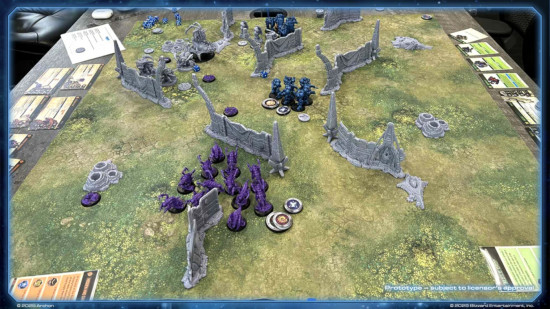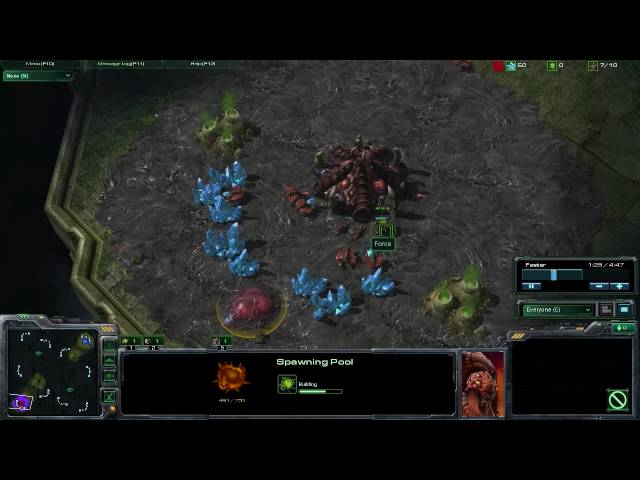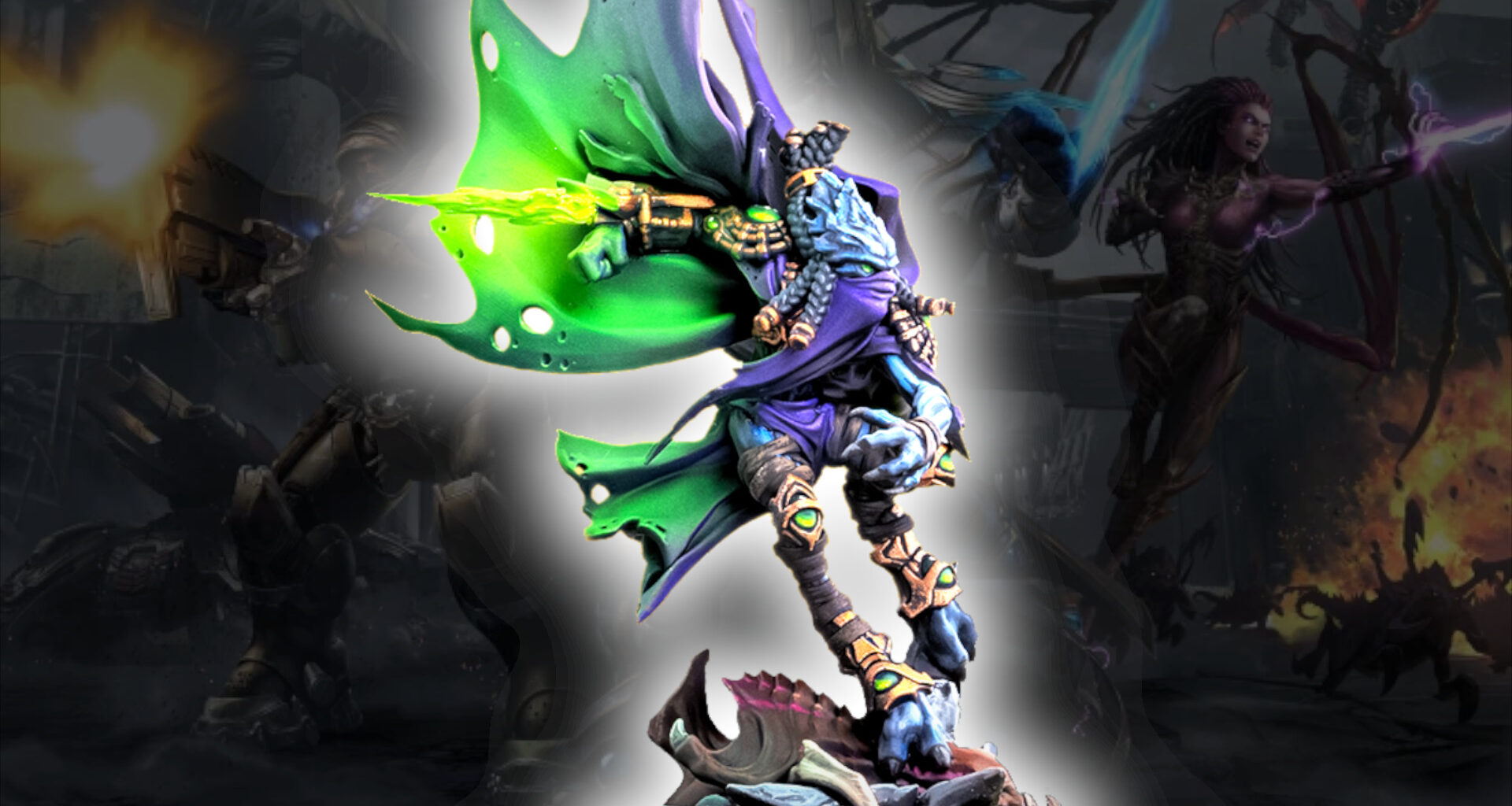In just one week, Archon Studio will fully unveil the Starcraft Tabletop Miniatures Game to the public at the massive Essen Spiel convention in Germany. It will be the gaming public’s first chance to playtest the upcoming miniature wargame. We spoke to Jarek Ewertowski, CEO at Archon and a lifelong Starcraft fan, to find out what players should expect.
Starcraft and its sequel are some of the best RTS games ever made, icons of the genre – but converting their real time gameplay into a turn based miniature wargame inevitably means abstracting some elements away. Talking to Ewertowski, I got the impression that the original videogames were proving to be a source of truly excellent ideas for the Starcraft tabletop miniatures game.

Hybrid activation system
“We decided to go with a hybrid activation system” for units, Ewertowski says. “The game still uses three phases” – similar to Warhammer 40,00 – but within each phase, players alternate activating units. “The first phase is a movement phase, and this is when we alternate our activation – I go, I activate my unit, then it passes to you, and then once you finish, it goes back to me”. Simple enough.
But “the first player to finish activating” – either because they’ve run out of units, or because they simply pass – will be “the first player who’s going to start the next phase, which is the assault phase”. “The assault phase is basically your shooting phase and your charge phase”, with players alternating as they either make ranged attacks or charge into melee with their units. And once again, the first player to wrap up their activations in this phase gets to act first in the combat phase, when hand to hand fights are resolved.
“It gives you this tactical depth”, Ewerotowski says, “Sometimes you just want to be first to do a shooting action, or you want to be first to fight in combat – you have to think tactically about when you’re going to pass”. It puts me in mind of those moments in RTS matches when you have to give up on one part of the map and concentrate on another, surrendering the momentum in one location to drive the fight in another.

Boards and deployment
The game is balanced around games sizes, a small game with a three foot square board, and a large format game with a board closer to three feet by six feet. The model count for a full game is between 30 and 40 models per side, and fewer for Protoss and likely more for the Zerg. So far, so similar to Warhammer 40k – until you learn about the deployment system.
“The system of deployment we have in this game is like nothing you’ve seen in other tabletop miniatures games”, Ewertowski claims. Models have both a points value – which comes out of a 1,000 point allowance for a small game or 2,000 points for a full game – and a supply value. “When you start the first round of the game, you start with no units on the table, just terrain and entry points, and you start your activation by bringing units on from your entry points”.
But there’s a limit on the total supply value of units you can have on the board at once. “You’re going to deploy about 60% of your army [in the first turn], but 40% of the army will be kept in reserves. Once you lose some units on the table, or if your supply increases – because it keeps increasing every turn – you can bring more units onto the table”.
It’s not a completely novel system – Conquest, Last Argument of Kings and Warhammer Age of Sigmar: Spearhead use mandatory staggered deployment – but it certainly feels fitting for a game inspired by an RTS to have a unit cap.
Ewertowski says the system was designed to prevent the “point of no return” problem he often sees in wargames, “the moment you know on turn two or maybe three that you’ve already lost the game, and there is no way to come back because you don’t have tools, you don’t have resources to actually carry on the battle”.
He also thinks it’s helpful for “solving the main problem with alternating activation systems of one player having more units than the other”. For most of the game, players will have no more than one unit more than their opponent. “It helps push the point of no return until really the last round of the game”.
I’m reminded of my experience playing the (excellent) Halo: Flashpoint, which is themed on Halo multiplayer and allows players to respawn units when destroyed. In that game it’s impossible to cripple the opponent’s force beyond the point where they can interact, which shifts the emphasis heavily onto objective-based gameplay rather than attrition. The system in Starcraft sounds more like deploying a large but finite army stage by stage – and there should be some really interesting decisions about sequencing your deployments.

Army balance
Ewertowski doesn’t get into details about army construction, but it seems to be quite open. “You could spam just one type of unit”, he says, but “it’s not going to be that effective”. He hopes to promote balanced army composition via the classic Rock – Paper – Scissors RTS balancing triangle of making some units much better against specific classes of other unit.
“We wanted to give that Starcraft feeling where you have those units which are a very nice counter to, say, armor units, but not so much against some fast, quick, light units”, Ewertowski says, “like Marauders, for instance, they’re extremely good against anything which is armored, but not so much against Zerglings or other Marines”.
In practical terms, this is being handled with the ‘Surge’ mechanic, a bonus die that a unit will roll when it attacks a specific class of unit, and which – if the Surge roll is successful – will strip the target’s armor saves.
As well as picking units for your army, you’ll bring two or three Tactical cards to each game. Some of them are themed around specific videogame buildings, and others on named strategies popularised in the e-sports scene.

Ewertowski says “we wanted to replicate this, give people ways to actually play Six Pool” – a Zerg opening that rushes out six Zerglings as fast as possible to try and shut the enemy base down before they can establish – “or having a way of using the Terran dropship in the game”.
The dropship Tactical card promises to have a neat interaction with the supply mechanics. “Just imagine you dropship your Terran marines somewhere in the middle of the table, they do their own attacks, they uptick on a control point – and then at the end of the round you use some strategic assets to get them off the table, increase your supply pool, and all of a sudden you can bring in a Goliath from another angle”.
The Tactical cards will also provide a way to limit the use of the most powerful unit abilities. “We wanted units to have some quite powerful abilities, but we didn’t want people to spam those abilities across the board”. So their use is tied to certain Tactical cards, and is limited to a single unit activation.
The ideas that Starcraft the Tabletop Miniatures Game is taking from the original videogames seem genuinely promising, and pretty novel. There is one very traditional element, though – the dice. “There was loads of discussion internally. I was the only one defending D6 dice, and I won because I’m CEO”, Ewertowski jokes.

The first Starcraft miniature will be on sale during Essen Spiel – the Protoss hero Zeratul, pictured above – both from the Archon Studio booth and via its online store, from October 23-26. Make sure you tune back with Wargamer on the 23rd – we’ve got more to tell you from our interview with Ewertowski!
If you’re excited for the Starcraft Miniature Game and want to meet a friendly community of wargamers, come and join us in the official Wargamer Discord community!

